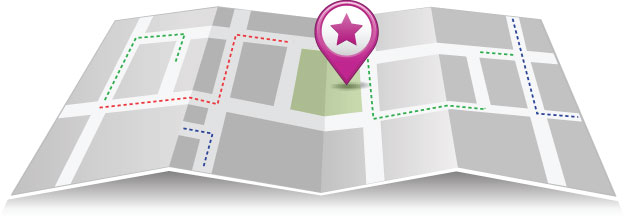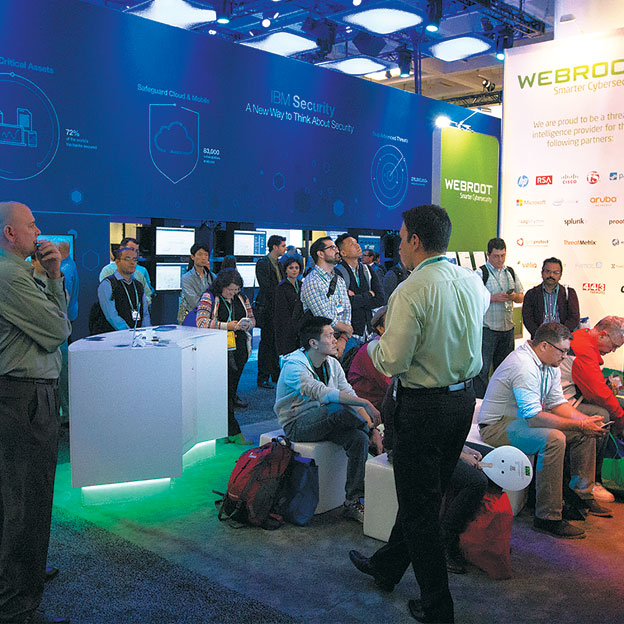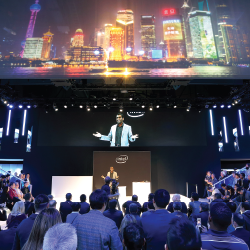|
case study
Webroot's RSAC Reboot
Cindy McElhiney supersizes Webroot Inc.'s exhibit-marketing investment in the annual RSA Conference, enabling the company to dominate attendee mindshare and collect more than four times as many sales leads as the previous year. By Claire Walling
When it comes to exhibiting, it's not just about erecting the best booth or deploying the most exciting promotions. It's also about being at the right shows in the first place. And assuming you've already identified those events, it's about investing the appropriate portion of your marketing budget at each one. Spend too much on the wrong show, and you've wasted precious funds. But invest too little in the right show, and you haven't optimized your efforts or reached your program's potential.
Smart marketers understand this. And thankfully for Webroot Inc., Cindy McElhiney falls into that bright bunch. When McElhiney joined the Webroot marketing team in 2013, she took one look at the company's exhibit program and realized that there was an imbalance she needed to correct. She discovered that the RSA Conference (RSAC), held annually at the Moscone Center, attracted more than 20,000 attendees who fell within Webroot's target market. But the company had a sketchy history with RSAC. As a result of decisions made by McElhiney's predecessors, Webroot opted out of the event in 2012, and showed up with a modest 10-by-20-foot booth and scant ancillary promotions in 2013. Under her care, however, Webroot's RSAC exhibit-marketing program was about to make an incremental about-face. 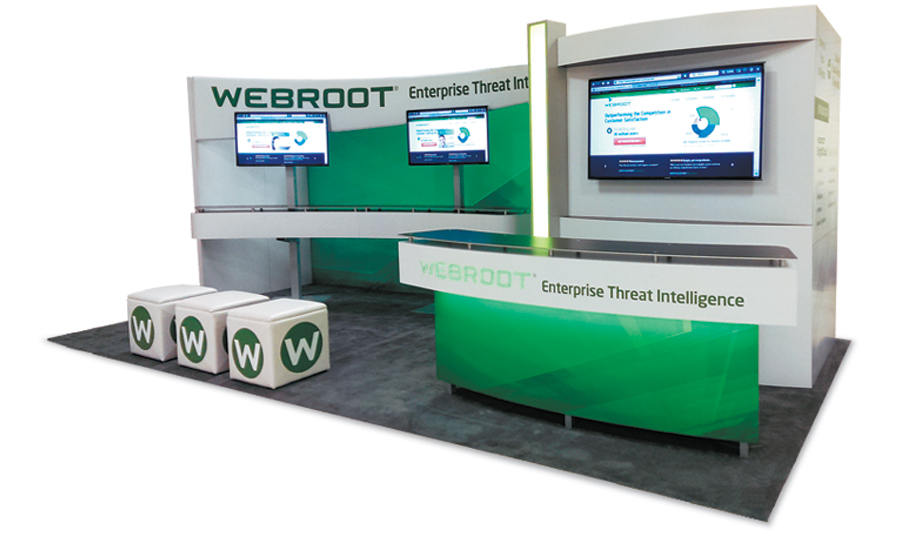
PHOTOS: SKYLINE EXHIBITS, RICHARD C. MELICK, WEBROOT INC., OYSTER.COM
GROWING PAINS
"I wanted to turn RSAC into our flagship show in terms of visibility and the amount of resources that we put toward it," she says. With only nine months between her first day on the job and RSAC 2014, McElhiney knew she wouldn't be able to upend the program until the following year. But she did want to start moving toward a more robust presence. So while Webroot would ship the same 200-square-foot booth to San Francisco, the company would also host an off-site VIP event and sponsor the show's registration area. The party, additional signage, and heightened exposure generated via the sponsorship was all well and good. But for McElhiney, it was simply the first step toward a strategic mission to own the show in 2015. In order for Webroot Inc. to exhibit in close proximity to its primary competitors at the RSA Conference, the cybersecurity firm needed to spring for a 30-by-30-foot booth space. But that threw a wrench into the company's plans. Its existing 10-by-20-foot in-line property didn't even come close to filling the new, supersized booth space. Mission: Domination To make a big impression on show goers and position Webroot as one of the major players at the 2015 show, McElhiney wanted the company's emerald-hued logo to be omnipresent at RSAC. To make that happen, the cybersecurity firm would spring for a booth space more than four times larger than its previous show-floor real estate. Furthermore, it would unleash a series of targeted promotions designed to strengthen relationships with clients and educate prospects about Webroot's expansive product portfolio. But Webroot's exhaustive marketing efforts wouldn't be just for show; they'd be crucial to standing out among some 400 other exhibitors, including many of the company's competitors. The objective for RSAC 2015 was simple: to promote Webroot's collective threat-intelligence solutions for enterprises and original equipment manufacturer partners (OEMs). And while virtually every attendee at the show was of interest to Webroot, the cybersecurity company was after the whales, i.e., large companies and websites with complex security needs, in particular. To that end, much of its trade show resources would be directed toward fostering face time with those high-value decision makers. An off-site meeting room, a swanky VIP party, an end-of-show happy hour, and more would afford Webroot's sales staff plenty of one-on-one interactions with the VIPs the company was targeting. Still, despite its concentrated efforts to snag the big fish, Webroot would also be casting a wide net at the show. After all, while the whales were top priority, even the krill represented potential revenue. To that end, the company's silver-level sponsorship of RSAC would afford it a prime booth location and the opportunity to deliver its message directly to attendees via hotel room drops. Moreover, Webroot once again sprang for an a la carte sponsorship of RSAC's registration area, meaning that its logo would be the first thing that attendees saw when they stepped into the Moscone Center to retrieve their show badges. "We wanted to connect with people via various touchpoints throughout the show," McElhiney says. As such, she wanted to take advantage of every feasible opportunity to insert Webroot's logo or key messages into the RSAC environs, and therefore command as much of attendees' mindshare as possible. A comprehensive new plan for RSAC had been set in motion; now it was up to McElhiney and her team to transform that vision into reality.
DOMINATION DECONSTRUCTED
Webroot Inc. wanted to dominate attendee mindshare at the RSA Conference in San Francisco. To accomplish that goal, trade show and events manager Cindy McElhiney sought to foster intimate conversations with key prospects and clients, and to educate other show goers who might not be aware of the company's vast portfolio of cybersecurity products. 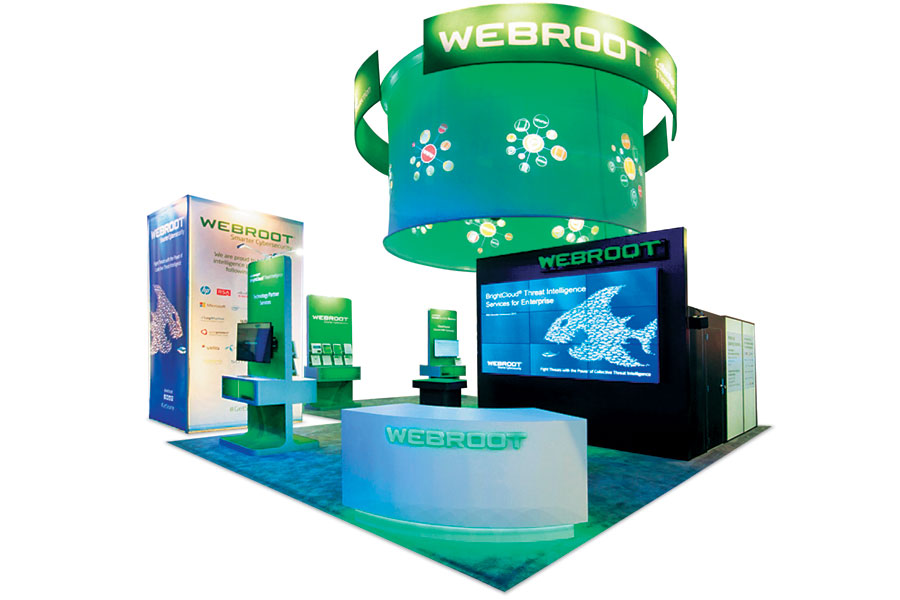
Go Big or Go Home The 10-by-20-foot property Webroot had erected at RSAC in the past wasn't just cramped; it forced the company to exhibit amid a sea of similarly sized in-lines, McElhiney explains. "In order to occupy a premium area of the show floor, alongside the big players in our industry, we would need to spring for a bigger booth space." But once McElhiney had reserved a 30-by-30-foot swath of show-floor real estate, she was faced with another conundrum: None of the properties in Webroot's inventory even came close to that size. To remedy that, Webroot began working with St. Paul, MN-based Skyline Exhibits to build a booth that embodied her bold new approach for the show. "We decided that if we were going to spend the money to book such a large space, then we would also spend the money to build a nice, new exhibit," she says. Other preparations for RSAC 2015 quickly followed suit. While McElhiney ironed out the tactical minutiae for the booth, Webroot's sales team mined its database of cybersecurity professionals. Pre-show promotions began with a plethora of email missives to everyone in the company's Salesforce database. Exact verbiage varied depending on the intended recipient and the timing of the message, but each one directed recipients to a show-specific landing page: www.webroot.com/rsac2015. There, attendees could schedule a meeting during the show, obtain a complimentary exhibit hall pass, download reports on various cybersecurity issues, and more. Sales staff also reached out to top clients and prospects via phone calls and personal emails to set up meetings during the show as a part of the efforts to snag the big fish. "Our sales team worked really hard in advance of the show, reaching out to folks they've met over the years," McElhiney says. "Because RSAC is such a huge event for our industry, a lot of these people travel to San Francisco. So it's a prime opportunity for one-on-one time." Meanwhile, planning was underway for Webroot's VIP bash. The swanky affair would be held on the opening night of the show, directly following the conference's own opening-night reception. McElhiney had staged a similar event the year before, but it was held in a smaller venue, and as a result, the guest list was contained to about 160 clients and prospects. For 2015, however, McElhiney was able to secure a significantly larger space, and the guest list for the event would grow in accordance with that extra square footage. Webroot sales reps subsequently compiled the names of a few hundred clients and prospects that have desks in the C suite at their respective companies, sent them save-the-date emails and 7-by-15-inch printed invitations, and made several follow-up calls to confirm RSVPs. 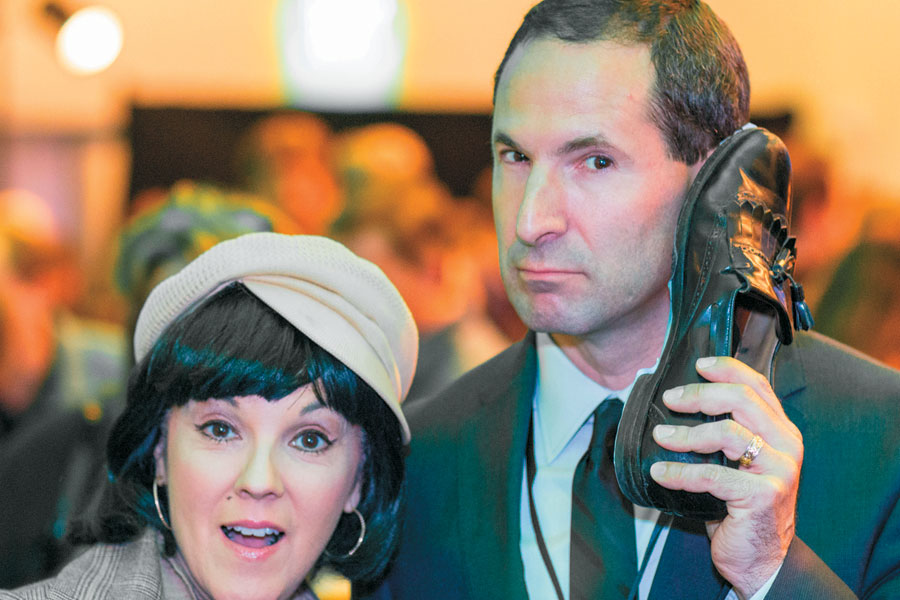
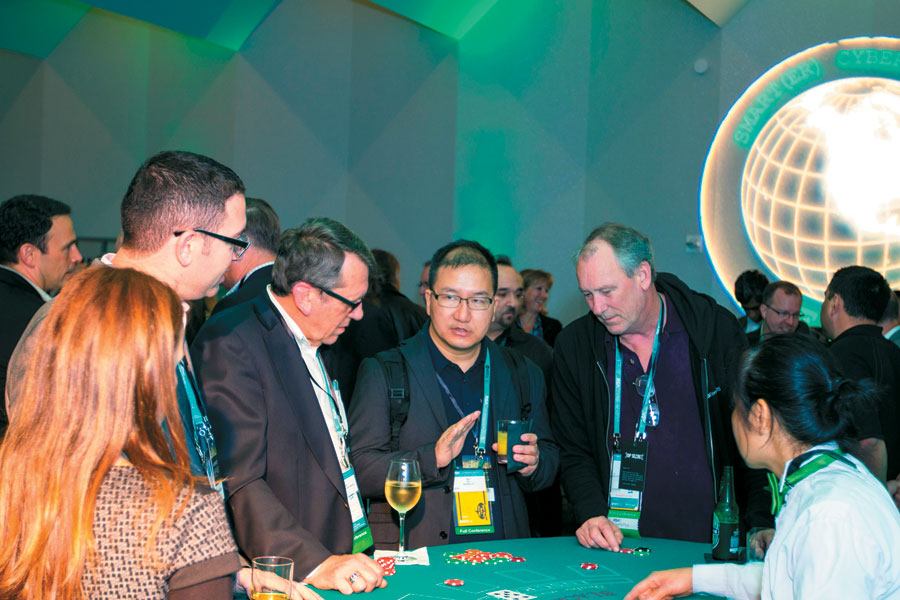
VERY IMPORTANT PARTY
As it had in 2014, Webroot Inc. held an exclusive VIP party on the opening night of the 2015 RSA Conference. Guests sipped on signature cocktails while actors dressed as Maxwell Smart and Agent 99 (from the 1960s TV show "Get Smart") circulated through the crowd to underscore the company's new "Smarter cybersecurity" tagline. 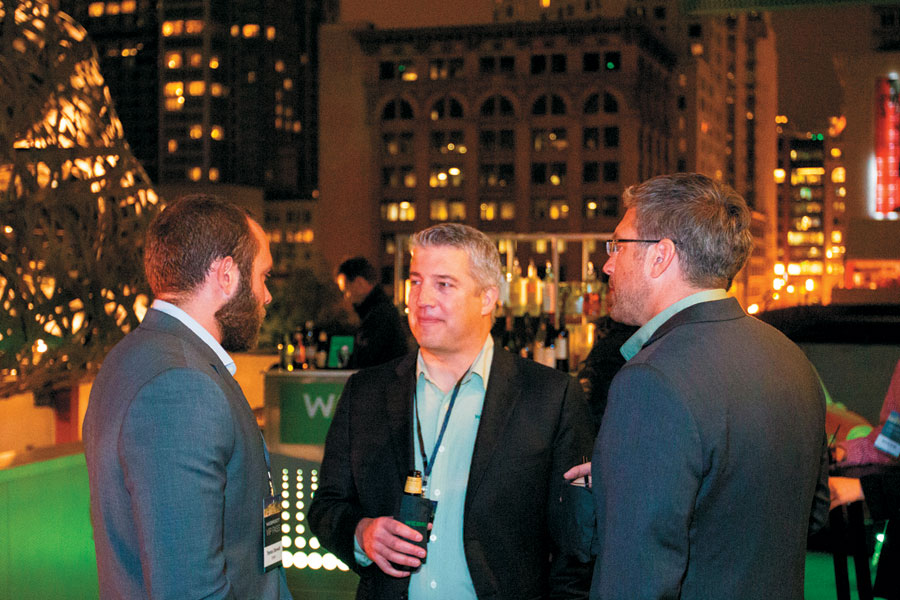
The VIP Treatment McElhiney knew that the aforementioned whales were a top priority for Webroot. She also knew those decision makers were in high demand and would also be courted by all of her company's competitors. So to target this specific subset of RSAC attendees, she decided to strike early and often. When RSAC 2015 kicked off with a welcome reception held in the exhibit hall on April 20, Webroot followed suit with its VIP soirée immediately after that event. Approximately 300 guests took a short jaunt out of the Moscone Center and into the W San Francisco down the street. Once guests had ascended to the hotel's fourth floor, they discovered a 1960s, espionage-themed cocktail affair. Earlier that year, Webroot had unveiled a short tagline, "Smarter cybersecurity," to append its emerald-green typographic logo. "We realized that the logo itself wasn't telling people much about the company," McElhiney says. "The new tagline tells people outside of the industry that we're in cybersecurity, and it tells people who already know us that we're smarter than the competition." Since Webroot was unveiling that new tagline to its top tier of customers and prospects at the party, McElhiney and her team felt it was fitting to create a coordinating theme. "We brainstormed all sorts of ideas around the word 'smarter,' and we came up with 'Get Smart,' based on the 1960s TV show with Maxwell Smart and Agent 99," she says. "We even included a shoe phone amid our decorations and hired actors dressed as the show's characters to work the room." After several hours of sipping drinks, listening to jazz music, and chatting with fellow attendees and Webroot sales staff, guests began to make their way toward the doors to catch some shut-eye before RSAC started in earnest the following morning. As they did, event staffers handed them opulent parting gifts. "We took inspiration from the Oscars and decided to give our guests gift bags as a thank you for attending our party," McElhiney says. Webroot's gift bags included a Roku Internet-streaming device, a CD recording of the band that played at the party, a disc containing a sampling of its cybersecurity products, and a Ghirardelli chocolate bar. According to McElhiney, those products added up to a total value of nearly $120. But promos aimed at this exclusive tier of attendees didn't stop there. McElhiney also booked a meeting suite at the W San Francisco. There, prescheduled meetings took place at one of four sofa settees, and attendees helped themselves to a spread of drinks and snacks. This setup offered a secluded environment for sales staff and key clients and prospects to have intimate conversations and hammer out contracts – a setting that McElhiney doesn't believe would have been possible to create on the show floor. 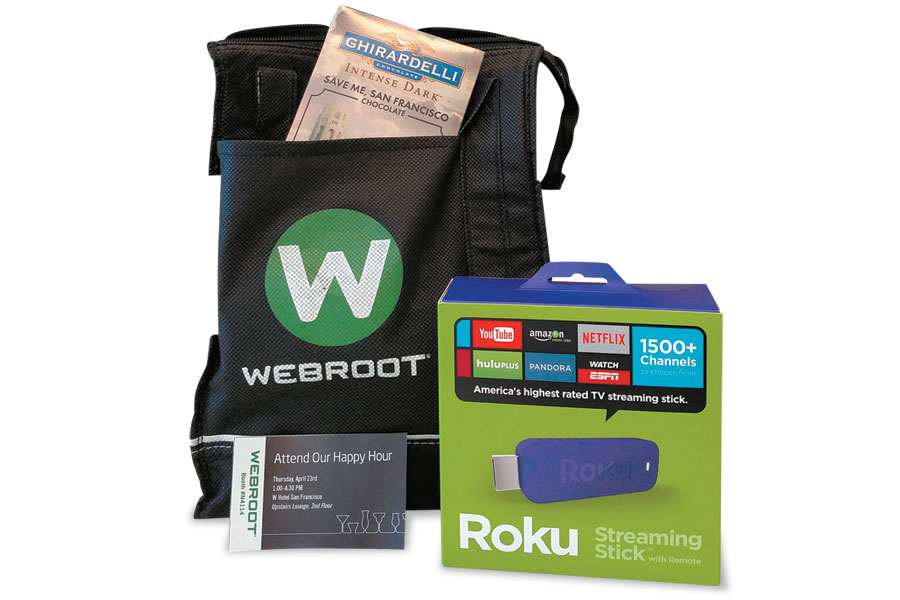
STAR-QUALITY SWAG BAGS
As guests left the VIP party, staffers gave them lavish gift bags valued at roughly $120. Each one contained a Roku Internet-streaming device, a demo of the company's products, a CD recording of the band that played during the party, and more. Webroot's string of tactics targeted toward key decision makers culminated with a happy hour, held during the final hours of the show. In contrast to the VIP kickoff party, this was a casual affair without a set guest list. Rather, McElhiney armed Webroot staffers with stacks of 3-by-5-inch invitations to the event, and they were asked to distribute them to media reps, analysts, clients, or prospects with which they made a poignant connection during the show. "By Thursday, there were several hundred people who we'd had conversations with throughout the week," McElhiney says. "This was a fun way to wrap up the show and say 'Hey, it was great to see you – have a drink on us!'" Furthermore, this event and the VIP reception on the show's opening day allowed McElhiney to bookend RSAC, ensuring the company was among both the first and last brands with which these high-value attendees engaged. Collectively, these promotional tactics were crucial to acquiring face time with busy VIPs during RSAC. But while whales were the optimal targets, they weren't the only fish in the RSAC sea that Webroot was after. As such, McElhiney needed to devise additional tactics to woo other prospects, ensuring every attendee had an opportunity to learn more about the cybersecurity firm, and allowing Webroot to learn a little more about them. The Best for the Rest While VIPs were sipping cocktails and being serenaded by a jazz band, 3,800 attendees staying at select hotels also received a unique experience courtesy of Webroot. They returned to their rooms from RSAC's opening reception to find a small, black package waiting for them. A green sticker on the box's lid read "See What Smarter Cybersecurity Looks Like." Inside, they found a branded, white View-Master toy and an accompanying note instructing them to click through the enclosed reel of images (which conveyed key messages) to see if they were a winner. "The intent was for attendees to engage with the room drop, not just leave it passively sitting on the desk in their hotel room," McElhiney says. One of two scenarios occurred: 1) The final slide informed the recipient that he or she was not a winner, but could stop by Webroot's booth to pick up a customized reel of 3-D images of iconic San Francisco landmarks, or 2) for 100 of the roughly 3,800 room-drop recipients, the final slide said, "WINNER! Come to Booth #N4114 to claim your smartwatch & fitness tracker (a $99 value)." The prize tied into Webroot's "smart" theme, and clued those who hadn't attended the VIP party into the new tagline. The next morning, when attendees stepped into the Moscone Center lobby to retrieve their show badges, they were greeted with the Webroot logo on practically every surface, including the kick panels for the registration desk and splash pages for the touchscreen consoles. "As soon as attendees walked into either side of the Moscone Center to register, they saw the Webroot logo all over the place," McElhiney says. "That gave us huge visibility." Next, attendees beelined to the company's brand new 30-by-30-foot booth. Staffers greeted attendees at the aisle and peppered them with several conversational yet pointed questions about their organizations' needs before directing them to one of four demo stations: threat intelligence for OEMs, threat intelligence for enterprises, enterprise endpoint protection, or secure Web gateway. An assistant assigned to each station would then explain that product to the booth visitor via a kiosk connected to the Internet, while the staffer who had originally greeted them would tag-team the presentation, or, if the booth was busy, return to his or her post working the aisle. "If someone from Google were to walk up to our booth and ask, 'What can you do for me?' we would escort him or her to the threat intelligence solutions for enterprises station," McElhiney explains. "But if someone from a smaller company came by, we'd likely direct him or her to the endpoint protection demo station." Additionally, attendees who brought their View-Master room drops to the booth were also given the appropriate prize (either a Striiv Fusion fitness tracker or a custom reel of 3-D images of San Francisco landmarks). 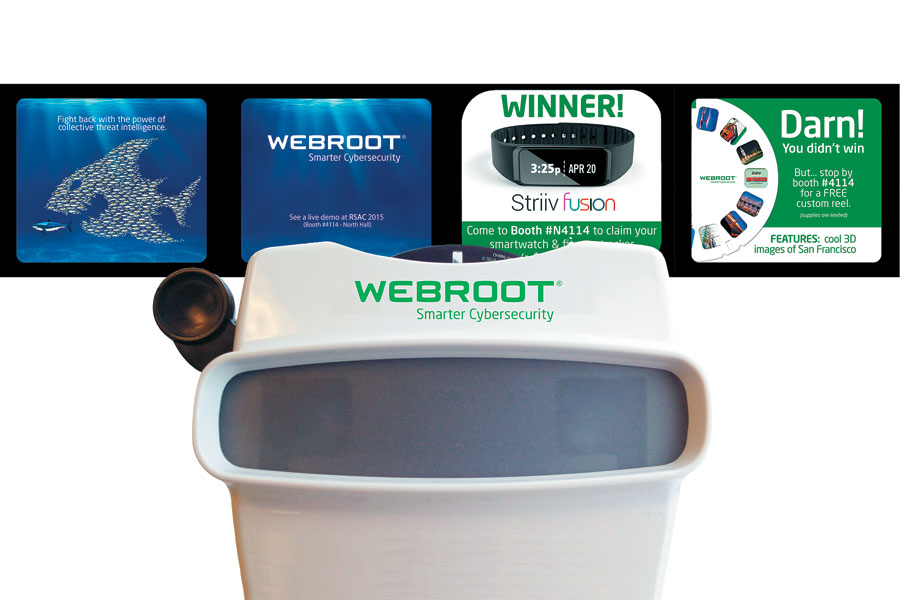
Attendees who received View-Master room drops were encouraged to return them to the booth to retrieve a prize: either a custom image reel of San Francisco landmarks or a Striiv Fusion fitness tracker.
Next, staffers asked attendees if they would like to attend a presentation on mobile app reputation, endpoint security, or threat intelligence. The 10-minute talks were facilitated by a Webroot subject-matter expert, and were offered every 45 minutes in the eight-seat in-booth theater. At the end of each presentation, booth staffers gave attendees a laser pointer as a token of appreciation for their time. Visitors curious to learn more about Webroot's approach could partake in a demonstration of its contextual database, which tracks viruses floating around cyberspace and feeds intelligence for the bulk of the company's software products. So to demonstrate this abstract technology in a tangible way, the company created a visual representation of how websites and viruses connect to one another, and presented it as a conceptual virtual- reality experience via a smartphone in a Google Cardboard device. Staffers took a dedicated smartphone with an app preinstalled and placed it in the front of the brown box-meets-goggles headset. When attendees looked into the device, they saw island-like dots representing various apps and websites, as well as paths between those points that depicted how Webroot calculates reputation scores for each one. Just as Webroot's VIP tactics helped to reel in the whales, these for-the-masses strategies ensured all RSAC attendees saw Webroot's emerald logo everywhere they went during the show, and had a chance to learn the ins and outs of the cybersecurity company's product portfolio – not just listen to a quick sales pitch. That's an approach the information-security professionals at RSAC appreciated, and following the show, McElhiney was armed with solid results to prove it. 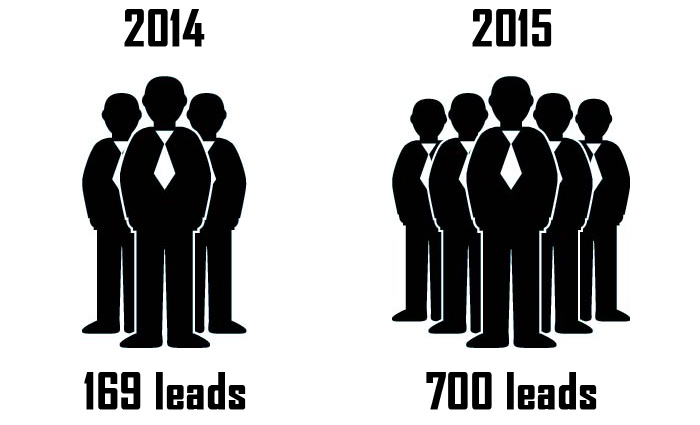
EPIC EXHIBIT TURNAROUND
Seeing GreenUnder the care of Cindy McElhiney, Webroot Inc. saw its lead counts from the RSA Conference skyrocket. The company's leads at RSAC 2015 marked a 314-percent increase compared to the previous year's show – a figure more than double Webroot's pre-event goal. By the time the last cocktail was sipped, the final meeting was adjourned, and every attendee exited the booth, one thing was clear: McElhiney's new RSAC strategy had worked. During the 18 hours that the show floor was open, Webroot staffers scanned more than 700 badges, a 314-percent increase over the 169 they tallied at RSAC 2014, and more than double the company's pre-show goal. The VIP bash enjoyed similar success, with more than 300 IT decision makers in attendance, practically doubling the previous year's metrics. On the meetings front, Webroot sales staff hosted intimate conversations with 45 OEM partners, exceeding the company's pre-show goal by more than a third and besting the number of meetings during the previous year's event. Public relations staffers also secured 15 press briefings with representatives from such venerable news outlets as Bloomberg Business, CBS News, Silicon Valley Business Journal, and more, resulting in nearly 20 media mentions during the week of RSAC alone. By zeroing in on an event with critical strategic importance, investing appropriately, and breaking from the status quo, McElhiney and her team crafted an audacious plan that yielded remarkable results, proving that Webroot's cybersecurity products aren't the only smart assets driving the company's success. E
|
|
|
||||||||||||||||||||||||||||
|
|
||||||||||||||||||||||||||||
|
TOPICS Measurement & Budgeting Planning & Execution Marketing & Promotion Events & Venues Personal & Career Exhibits & Experiences International Exhibiting Resources for Rookies Research & Resources |
MAGAZINE Subscribe Today! Renew Subscription Update Address Digital Downloads Newsletters Advertise |
FIND-IT Exhibit & Display Producers Products & Services Supplier to Supplier All Companies Compare Get Listed |
EXHIBITORLIVE Sessions Certification Exhibit Hall Exhibit at the Show Registration |
ETRAK Sessions Certification F.A.Q. Registration |
EDUCATION WEEK Overview Sessions Hotel Registration |
CERTIFICATION The Program Steps to Certification Faculty and Staff Enroll in CTSM Submit Quiz Answers My CTSM |
AWARDS Sizzle Awards Exhibit Design Awards Portable/Modular Awards Corporate Event Awards Centers of Excellence |
NEWS Associations/Press Awards Company News International New Products People Shows & Events Venues & Destinations EXHIBITOR News |
||||||||||||||||||||
|
||||||||||||||||||||||||||||



